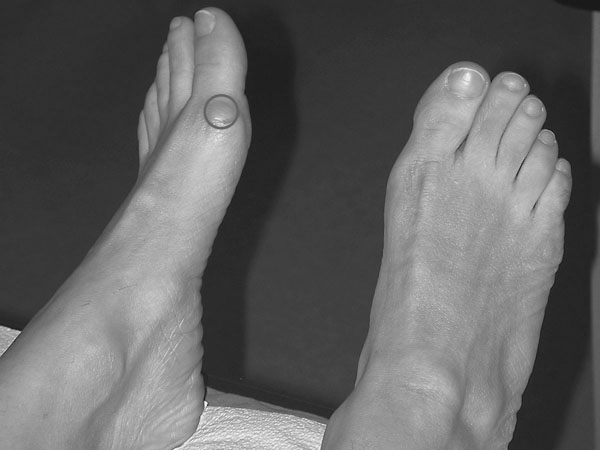A bunion, according to Western pathology, is an abnormal prominence on the foot in the inner aspect of the first metatarsal head with bursa formation and fluid accumulation. Etiologies include postural problems such as variation in the position of the first metatarsal because of excessive rolling of the ankles (or pronation of the foot), trauma to the local area, shoes that are too small, osteoarthritis or rheumatic arthritis of the big toe. Other mechanical problems may also affect hallucis longus, the big toe.
The treatment of bunions, as well osteoarthritis of the first metatarsophalangeal joint, with Oriental medical modalities is a curious clinical adaptation to an age-old problem. Bunions can be exceedingly painful for patients who suffer from them, and many do, although perhaps not as a major complaint to the acupuncturist because the patients may not know the benefits of acupuncture for this condition. Typically, patients report discomforting tenderness of the toes. There may be slight swelling of the joint, and shoes may aggravate the patient’s condition. As the problem becomes more chronic, pain tends to worsen and joint motion may become limited.
In Japanese acupuncture, bunions or osteoarthritis of the big too are referred to as “sugar toes.” They are so named because the theory behind their appearance is that excess sugar consumption, caused by the failure of the spleen to transform and transport sugar in foods, results in damp. The damp then leads to the formation of phlegm. The phlegm congeals such that an actual bony deformation appears.
Note that the bunion is bordered on either side of the first metatarsal bone by acupuncture points. Distally SP-2 (da du) and proximally SP-3 (tai bai) are involved. Spleen 2 is the fire point and the tonification point of the spleen, and as such is used to treat spleen vacuity such as the failure of the spleen to transform and transport the sugar, aka the damp. As its earth point and horary point, Spleen 3 balances and strengthens the spleen, stabilizes insulin production and benefits diabetic disharmonies. Sugar can be viewed energetically as both hot and damp, and hence we are not surprised to see the occurrence of corresponding hot (painful, red, and inflamed) and damp (toe enlargement or fluid accumulation) pathology at these points, such as the congealed phlegm.
The typical Western treatment usually begins with physical therapy and local injections. Surgical removal of the bunion may then be recommended. This treatment is not only expensive and painful, but is usually ineffective. The bunion may reoccur because the underlying causes of sugar consumption and metabolism problems have not been addressed. Now the toe may become even more painful because of the trauma of local surgery. Additionally, the creation of a scar, along the spleen channel, may further inhibit the functional role of the spleen as the scar interrupts the qi and blood flow of the channel.
Remember that the Oriental view of a scar is that it is a “potential” organ/channel disturbance. What this means is that any scar may lead to the development of pathology on the associated channel, and even more distally to the organ, because its presence may interfere with the flow of qi and blood. Whether the scar is actually clinically significant is ultimately determined by palpation of its discrete borders. Objective factors related to appearance, such as discoloration, swelling within or beyond its borders, and oozing, may be an indication that the scar is problematic. The patient may experience criteria such as pain, pulling, itching, numbness, heat, cold, distention, referred sensation, emptiness, or weird feelings. The criteria are usually correlated with some disturbance of qi and blood in the area. Palpation is a reliable methodology to determine if the scar is clinically significant, and if so, it should be treated.
Invariably, patients I have seen with bunion problems have had one of the following illnesses relating to sugar history: diabetes, hypoglycemia, and sensitivity to sugar, sugar cravings, sugar allergies, pancreatic cancer, or leaky gut syndrome.
My preferred treatment of this disorder is, locally at least, very simple, effective and fast. There are three major treatment modalities to choose from and they are described below in Table 5.1.Figure. 5.1 depicts sugar toe pathology. For those who may not be familiar with this tool, Figure. 5.2 illustrates the tiger thermie warmer (the smaller instrument in the photograph), the lion thermie warmer, and the moxa used in them. There are two forms in the Appendix that describe how to use the tiger thermie warmer and the Chinese liniment Zheng Gu Shui respectively. Copies of these may be made and given to patients so they know how to use the tools correctly.

Stay updated, free articles. Join our Telegram channel

Full access? Get Clinical Tree





